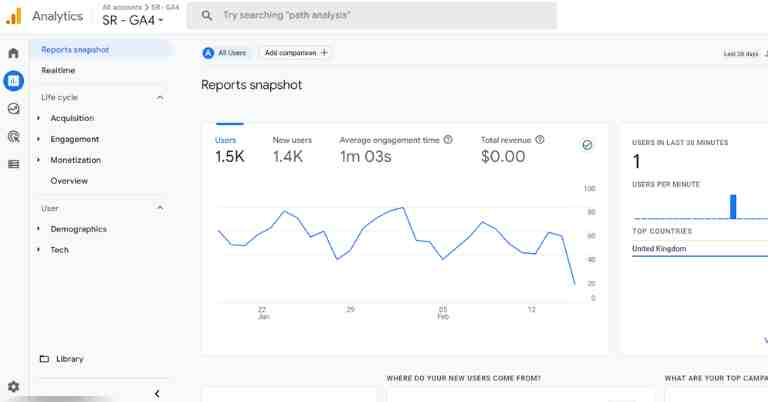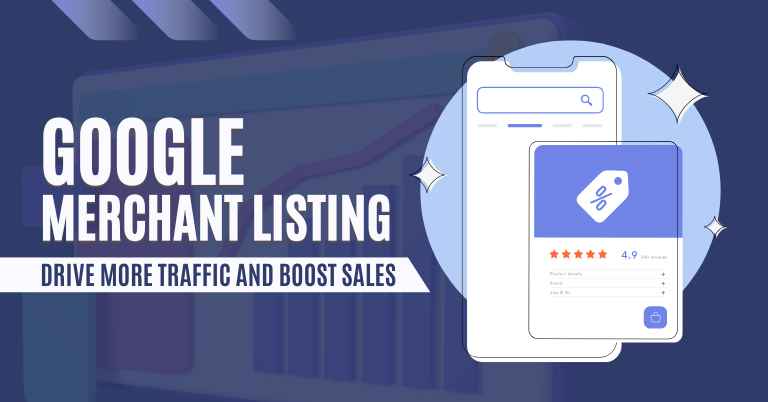Google Analytics is a powerful tool that provides valuable insights into website performance and user behavior. One of its key features is the ability to track website goals and conversions. However, there are certain types of data that Google Analytics goals are unable to track. In this blog, I’ll discuss what data is google analytics goals unable to track-
Google Analytics is a powerful tool, but it’s important to remember that it has its limitations. Understanding what data it can’t track is just as important as understanding what it can track, as this knowledge can help businesses make informed decisions and optimize their online performance.
- What is not a Benefit of Google Analytics Remarketing?
- Tracking and Analytics: Launch a Successful SEO Campaign
Let's See the Topic Overview
What Data is Google Analytics Goals Unable to Track?

There are certain types of data that Google Analytics goals are unable to track. These include phone calls, offline purchases, PDF downloads, video views, social media interactions, specific ad creatives, form abandonment, user behavior on other websites, and personal information. Understanding these limitations is important for businesses to effectively measure and optimize their online performance. By using other tools to track this type of data, businesses can gain a more complete understanding of their customer’s behavior and improve their online strategies. Let’s explain some of the limitations of Google Analytics and what data is google analytics goals unable to track-
1. Phone Calls
Google Analytics is unable to track phone calls made to your business. If your website has a phone number listed and users are clicking on it to call you, Google Analytics will not be able to track that as a conversion. In order to track phone calls, you will need to use call-tracking software.
Let’s say you run a small business that offers personal training services. You have a website that includes a phone number where potential clients can reach out to schedule a consultation. You have also set up goals in Google Analytics to track when a user submits a contact form on your website or makes a purchase for one of your training packages.
However, you notice that you are receiving a lot of phone calls from potential clients who found your website through a Google Ads campaign. You want to know which campaigns are driving the most phone calls and which of those calls are resulting in conversions (i.e., scheduled consultations or package purchases).
Unfortunately, Google Analytics is unable to track phone calls made to your business. Even if you have the phone number listed on your website as a clickable link, Google Analytics cannot track these clicks as a conversion. This means that you are missing out on valuable data that could help you optimize your Google Ads campaigns and improve the overall performance of your business.
To track phone calls, you will need to use call-tracking software. For example, you could use CallRail, which assigns a unique phone number to each marketing campaign you are running. When a potential client calls the phone number associated with a particular campaign, CallRail will record the call and provide you with valuable insights about the call, such as the source of the call, the caller’s location, and the length of the call.
With this data, you can determine which Google Ads campaigns are driving the most phone calls to your business and which of those calls are resulting in conversions. For example, if you see that one campaign is driving a lot of phone calls but few of those calls are resulting in scheduled consultations or package purchases, you may want to adjust the messaging or targeting of that campaign to better align with the needs of your potential clients.
Overall, while Google Analytics is a powerful tool for tracking website performance, it is unable to track phone calls made to your business. By using call tracking software, you can gain valuable insights into which marketing campaigns are driving phone calls to your business and which of those calls are resulting in conversions. This can help you optimize your marketing campaigns and improve the overall performance of your business.
2. Offline Purchases
If your business sells products or services offline, Google Analytics goals will not be able to track those purchases. This means that if a user visits your website, but makes a purchase in-store or over the phone, that purchase will not be tracked as a conversion.
If your business sells products or services offline, it can be challenging to track the effectiveness of your online marketing efforts. While Google Analytics is a powerful tool for tracking website performance, it is unable to track offline purchases. This means that if a user visits your website, but makes a purchase in-store or over the phone, that purchase will not be tracked as a conversion.
Let’s say you run a small boutique that sells clothing and accessories. You have a website where customers can browse your inventory and make purchases, but you also have a physical store where customers can try on items and make purchases in person. You have set up goals in Google Analytics to track when a user makes a purchase on your website, but you notice that many of your customers are actually making purchases in-store.
This means that you are missing out on valuable data that could help you optimize your online marketing efforts. For example, you may be running a Google Ads campaign that is driving a lot of traffic to your website, but you have no way of knowing whether those visits are resulting in in-store purchases.
To track offline purchases, you will need to use a combination of tools and techniques. One option is to use a point-of-sale (POS) system that integrates with Google Analytics. For example, if you use Square as your POS system, you can connect it to Google Analytics and track offline purchases as conversions. This will allow you to see which marketing campaigns are driving the most in-store purchases and which of those purchases are resulting in the highest revenue.
Another option is to use unique coupon codes for your online marketing campaigns. For example, you could offer a discount code that can only be used in-store. By tracking the usage of these coupon codes, you can get a better sense of how many customers are visiting your store as a result of your online marketing efforts.
Overall, while Google Analytics goals may not be able to track offline purchases, there are ways to track the effectiveness of your online marketing efforts in driving in-store sales. By using a combination of tools and techniques, you can gain valuable insights into which marketing campaigns are driving the most revenue for your business, both online and offline. This can help you optimize your marketing strategies and improve the overall performance of your business.
3. PDF Downloads
Google Analytics is able to track the number of times a user clicks on a PDF link, but it cannot track whether or not the user actually downloads or opens the PDF file. In order to track this type of data, you will need to use a PDF tracking tool.
If your website includes PDF files for users to download, you may be interested in tracking the number of times users download or open these files. While Google Analytics is able to track the number of times a user clicks on a PDF link, it cannot track whether or not the user actually downloads or opens the PDF file. In order to track this type of data, you will need to use a PDF tracking tool.
Let’s say you run a small consulting firm that provides whitepapers and case studies for users to download from your website. You have set up goals in Google Analytics to track when a user submits a contact form or makes a purchase, but you are interested in tracking how many users are actually downloading and opening your PDF files.
To track PDF downloads, you can use a tool like Google Tag Manager or a PDF tracking software like Adobe Analytics. With Google Tag Manager, you can set up a tag that fires when a user clicks on a PDF link, and that tag can trigger an event in Google Analytics to track the download.
Another option is to use PDF tracking software like Adobe Analytics, which allows you to track how many times a user downloads and opens a PDF file. This can provide you with valuable data about which PDF files are the most popular and which ones are driving the most conversions.
For example, if you have a whitepaper that is generating a lot of downloads but few conversions, you may want to take a closer look at the content of the whitepaper and see if there are ways to improve its effectiveness as a lead generation tool. On the other hand, if you have a case study that is driving a lot of conversions, you may want to feature it more prominently on your website and include it in your online marketing campaigns.
Overall, while Google Analytics is able to track the number of times a user clicks on a PDF link, it cannot track whether or not the user actually downloads or opens the PDF file. By using a PDF tracking tool, you can gain valuable insights into which PDF files are the most popular and which ones are driving the most conversions. This can help you optimize your website and online marketing campaigns to better meet the needs of your users and improve the overall performance of your business.
4. Video Views
Google Analytics can track the number of times a user clicks on a video link, but it cannot track whether or not the user actually views the video. If you want to track video views, you will need to use a video-tracking tool.
If your website includes video content, you may be interested in tracking the number of times users view those videos. While Google Analytics can track the number of times a user clicks on a video link, it cannot track whether or not the user actually views the video. In order to track video views, you will need to use a video-tracking tool.
Let’s say you run a travel blog that includes a video section featuring travel vlogs and destination guides. You want to track how many users are watching these videos and how long they are watching them, as this information can help you optimize your content and improve your user engagement.
To track video views, you can use a video trackings tool like Google Tag Manager or a dedicated video analytics software like Vidyard or Wistia. With Google Tag Manager, you can set up a tag that fires when a user clicks on a video link, and that tag can trigger an event in Google Analytics to track the video view.
Another option is to use a dedicated video analytics software like Vidyard or Wistia, which can track not only the number of video views, but also more advanced metrics like play rate, engagement rate, and drop-off rate. These tools allow you to gain a deeper understanding of how users are interacting with your video content and can provide you with valuable insights into how to optimize your content for better performance.
For example, if you notice that users are dropping off from your videos at a certain point, you may want to take a closer look at the content of that section and see if there are ways to improve its effectiveness. On the other hand, if you see that users are engaging with your videos for longer periods of time, you may want to focus on creating more video content that resonates with your audience.
Overall, while Google Analytics can track the number of times a user clicks on a video link, it cannot track whether or not the user actually views the video. By using a video tracking tool, you can gain valuable insights into how users are interacting with your video content and how you can optimize it for better performance. This can help you improve your user engagement, increase your conversions, and ultimately grow your business.
5. Social Media Interactions
While Google Analytics can track traffic from social media sites, it is unable to track social media interactions such as likes, shares, and comments. In order to track this type of data, you will need to use a social media tracking tool.
Social media has become a crucial part of any online marketing strategy. While Google Analytics can track traffic from social media sites, it is unable to track social media interactions such as likes, shares, and comments. In order to track this type of data, you will need to use a social media tracking tool.
Let’s say you have a website for your e-commerce store that sells handmade jewelry. You use social media to promote your products and drive traffic to your website. You want to know which social media platforms are driving the most engagement, as well as which products are being shared and liked the most on social media.
To track social media interactions, you can use a social media tracking tool like Hootsuite, Buffer, or Sprout Social. These tools allow you to monitor social media activity across multiple platforms, track likes, shares, and comments on your posts and even monitor mentions of your brand on social media.
For example, if you notice that your Facebook posts are getting a lot of likes and shares, but your Twitter posts are not performing as well, you may want to adjust your social media strategy to focus more on Facebook. If you see that a particular product is getting a lot of shares on Pinterest, you may want to create more products that appeal to that audience.
Social media tracking tools also allow you to monitor conversations about your brand on social media. If a customer tweets at your company with a question or complaint, you can use a social media tracking tool to respond quickly and provide excellent customer service.
Overall, while Google Analytics can track traffic from social media sites, it cannot track social media interactions such as likes, shares, and comments. By using a social media tracking tool, you can gain valuable insights into how users are interacting with your brand on social media and how you can optimize your social media strategy for better performance. This can help you increase your engagement, build your brand awareness, and ultimately grow your business.
6. Ad Clicks
While Google Analytics can track the number of times an ad is clicked, it cannot track the specific ad creative that was clicked. In order to track this type of data, you will need to use a third-party ad-tracking tool.
Online advertising is a critical component of any digital marketing campaign. While Google Analytics can track the number of times an ad is clicked, it cannot track the specific ad creative that was clicked. This means that you won’t be able to determine which of your ad creatives is performing the best, which can be a major issue for optimizing your ad campaigns.
To track the specific ad creative that was clicked, you will need to use a third-party ad trackings tool like DoubleClick or AdRoll. These tools allow you to monitor the performance of your ads in real time, track clicks and conversions, and optimize your ad campaigns based on the data you collect.
For example, let’s say you are running a Facebook ad campaign for your new line of running shoes. You have created several ad creatives, each with different copy and images, and you want to determine which ad creative is performing the best.
By using a third-party ad tracking tool, you can track the number of clicks and conversions for each ad creative, and compare the performance of each creative. You can also track which audience segments are responding best to each ad creative, and adjust your targeting accordingly.
Additionally, ad tracking tools can help you identify trends in your ad performance, such as which times of day or days of the week are most effective for running your ads. This information can be used to optimize your ad scheduling and maximize your campaign’s effectiveness.
Overall, while Google Analytics can track the number of times an ad is clicked, it cannot track the specific ad creative that was clicked. By using a third-party ad tracking tool, you can gain valuable insights into how your ads are performing and optimize your campaigns for better results. This can help you increase your ad click-through rates, improve your ad engagement, and ultimately drive more conversions and revenue for your business.
7. Form Abandonment
While Google Analytics can track form submissions, it cannot track when a user starts to fill out a form but does not complete it. In order to track form abandonment, you will need to use a form-tracking tool.
Forms are a key component of many websites, allowing users to input important information such as their contact details, payment information, or other data. While Google Analytics can track form submissions, it cannot track when a user starts to fill out a form but does not complete it. This can be a significant issue, as it means that you won’t be able to identify where users are dropping off in the form completion process.
To track form abandonment, you will need to use a form-tracking tool like Hotjar, Formisimo, or Mouseflow. These tools allow you to monitor the behavior of users as they fill out a form, and track when they abandon the form before completion.
For example, let’s say you have an online store with a checkout form that requires users to input their shipping and billing information. By using a form tracking tool, you can monitor the behavior of users as they complete the checkout form, and identify any areas where users are abandoning the form.
You might find, for example, that many users abandon the form when asked to input their billing address, or when asked to enter their payment information. Armed with this information, you can make changes to the form to improve its usability and reduce the rate of form abandonment.
Additionally, form tracking tools can help you identify patterns in the form completion process, such as which fields are causing the most user confusion or frustration. This information can be used to optimize the form, making it more user-friendly and reducing the likelihood of form abandonment.
Overall, while Google Analytics can track form submissions, it cannot track when a user starts to fill out a form but does not complete it. By using a form tracking tool, you can gain valuable insights into how users are interacting with your forms, and make changes to improve their usability and reduce form abandonment rates. This can help you increase the effectiveness of your forms and ultimately drive more conversions and revenue for your business.
8. User Behavior on Other Websites
Google Analytics is only able to track user behavior on your own website. It cannot track what users do on other websites or within mobile apps.
Google Analytics is a powerful tool that allows businesses to track a wide range of user behavior on their own website, such as page views, clicks, and conversions. However, it is important to note that Google Analytics is only able to track user behavior on your own website. It cannot track what users do on other websites or within mobile apps.
This means that if a user clicks on a link to an external website, Google Analytics will not be able to track their behavior on that site. Similarly, if a user opens a mobile app that is not owned by your business, Google Analytics will not be able to track their behavior within that app.
To illustrate this limitation of Google Analytics, let’s consider an example. Imagine you are a business owner who operates a website that sells outdoor gear. You have implemented Google Analytics to track user behavior on your website, such as which products users are viewing, adding to their cart, and purchasing.
One of the marketing strategies you use to drive traffic to your website is to post links to your products on various online forums and social media sites. When a user clicks on one of these links, they are taken to your website to view the product.
However, if the user decides to navigate away from your site and visit another site, such as a review site or a competitor’s site, Google Analytics will not be able to track their behavior on that site. This means that you will not be able to see how users are interacting with your competitors, or how they are researching your products and services.
Similarly, if you have a mobile app that is not owned by your business, Google Analytics will not be able to track user behavior within that app. This means that you will not be able to see how users are interacting with your business through the app, or what features they are using.
To address this limitation, businesses can use other tools and methods to track user behavior on other websites and within mobile apps. For example, you can use referral tracking to see which sites are driving traffic to your website, or use mobile app tracking to see how users are interacting with your app.
Overall, while Google Analytics is a powerful tool for tracking user behavior on your own website, it is important to remember that it cannot track what users do on other websites or within mobile apps. Businesses must use other tools and methods to gain a complete understanding of how users are interacting with their products and services across different channels and platforms.
9. Personal information
Google Analytics is unable to track personal information such as names, email addresses, and phone numbers. This is because Google Analytics is designed to protect user privacy and not collect personally identifiable information.
Google Analytics is a powerful tool that provides businesses with valuable insights into their website traffic and user behavior. However, it is important to note that Google Analytics is unable to track personal information such as names, email addresses, and phone numbers. This is because Google Analytics is designed to protect user privacy and not collect personally identifiable information.
While it may be tempting to try to collect this type of information through Google Analytics, doing so is a violation of Google’s terms of service and could result in the suspension or termination of your account. Instead, businesses should focus on collecting this type of information through other means, such as lead generation forms or surveys.
For example, let’s say you run an e-commerce store that sells clothing online. You want to collect customer email addresses so that you can send them promotional emails and updates on new products. Instead of trying to collect this information through Google Analytics, you can include a sign-up form on your website where users can voluntarily provide their email addresses in exchange for receiving your newsletter.
By collecting this information through a separate form, you are able to comply with Google’s terms of service and protect your users’ privacy while still achieving your business goals. Additionally, this approach allows you to target your marketing efforts more effectively and build a stronger relationship with your customers.
Final Verdict
In conclusion, while Google Analytics provides a wealth of information about website traffic and user behavior, it is important to respect user privacy and avoid collecting personally identifiable information through the platform. Instead, businesses should use other means to collect this type of information and focus on providing value to their customers in a transparent and ethical manner.
Keep Learning With Sajib Roy












